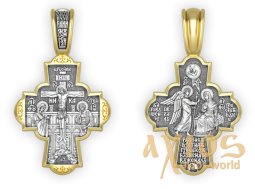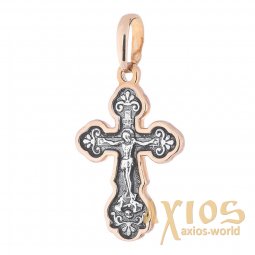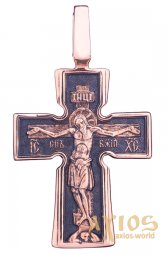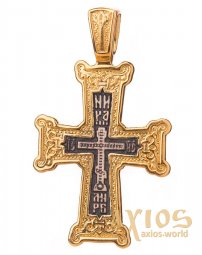Material: 925◦ silver, 999◦ gold plated
Average weight: 7.0 grams
Size: 39*24mm
Technique: casting, gilding, blackening, handmade.
Prayer: “We worship your cross, Christ, the honest guardian of the world, the salvation of us sinners, faithful to victory”
The front side of the cross is traditionally dedicated to Jesus Christ. The Lord is depicted crucified on the Cross on Mount Golgotha, which is symbolized by a rocky elevation. Golgotha is translated from Aramaic as "forehead, skull." According to Tradition, on this mountain was the tomb of Adam, reborn by the feat of the cross of the Savior. Adam's skull is usually depicted in a small cave at the base of the Cross. Above the head of the Lord on the crossbar is the inscription "INCI". A tablet was nailed to the Cross of the Lord: "Jesus of Nazareth, King of the Jews." With this inscription, the Jews wanted to laugh at Christ, not knowing that they were crucifying the true King of all kings. Having endured torment on the Cross, the Lord atoned for the sins of people, and, having risen from the dead, conquered death. Therefore, next to the titles of His holy name "IS XC" is written "NIKA", which in Greek means "winner". The crucifixion is surrounded by the words of the stichera to the Life-Giving Cross of the Lord: “We worship Your Cross, Christ, the honest guardian of the world, the salvation of us sinners, faithful to victory.”
The reverse of the cross is dedicated to the Most Holy Theotokos. It depicts the miraculous Svenska Caves Icon of the Mother of God, the most ancient Russian shrine, according to legend, painted by the first icon painter of Russia, a hieromonk of the Kiev-Pechersk monastery, St. Alipiy. On the icon, the Mother of God sits on a high throne. The Infant Christ, sitting on Her knees, blesses with the Divine right hand the Monks Theodosius and Anthony of the Caves, the founders of Russian monasticism and the founders of the Kiev-Pechersk Lavra, standing in front of the throne.
The Caves icon was in the Kiev-Pechersk Lavra until 1288. Glorified by many miracles, the relic was transferred to the Bryansk Assumption Monastery by the noble Grand Duke Roman Mikhailovich Chernigov. Being in Bryansk, the prince suddenly became blind. In the hope of healing, he sent to the Pechersk Monastery for the miraculous icon of the Mother of God. The icon was taken on boats, and during one of the stops it disappeared. It was found on the branches of an oak on a mountain near the Svena River. At this place, chosen by the Theotokos Herself for Her icon, the prince received healing. In gratitude, he founded the Svensky Monastery there, in which the icon was until its closure in 1925. Now it is kept in the Tretyakov Gallery in Moscow.
Currently, there are two miraculous lists from the ancient shrine in the Kiev-Pechersk Lavra. One of them, from the 17th century, is located in the Far Caves at the "coffin" of St. Theodosius. In the church in the name of all the Saints of the Caves there is a second image, of the 19th century, which, during the years of persecution against the Church of the New Age, was preserved by the archimandrite of the Kiev-Pechersk Lavra Spyridon, in the schema - Dionysius (Lukich, † September 2, 1991).








